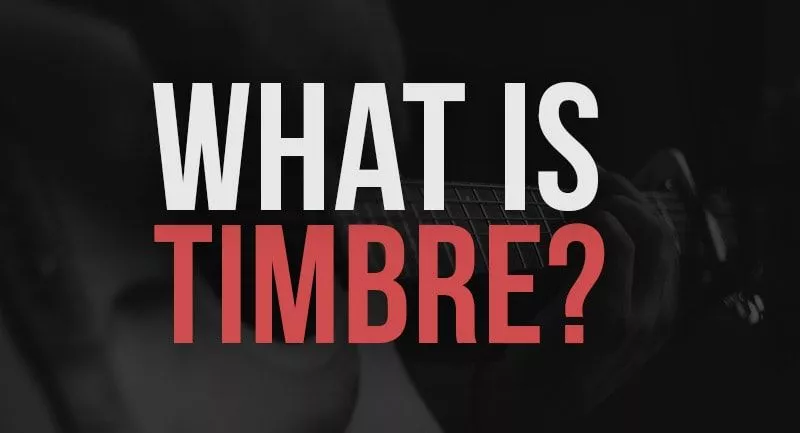This guide will answer what is Timbre in music, provide examples of timbres, and explain the differences in timbres. So what is a timbre in music?
What Is Timbre In Music?
Each sound has a specific tonal quality or color, which is called timbre. It makes the sound produced by any instrument different from others, even if they play the same note. For example, a guitar and piano can play the same note simultaneously but still sound different because of their unique tone color.
- What is Timbre In Music
- Example of Timbre
- How Do You Describe Timbre
- Types of Timbre
- The Definition of Timbre
- Pitch vs. Timbre
What is Timbre In Music?
Timbre is basically the tone color or tone quality of a sound, and it is the timbre that differentiates one sound from another.
For example, if the same note is played with the flute and the oboe, the pitch can be the same. However, the timbre of sound produced by each instrument will be different from the other.

Following are some of the words used whenever we describe a sound’s timbre:
- Bright
- Dark
- Reedy
- Brassy
- Harsh
- Noisy
- Thin
- Buzzy
| Brassy | Trumpet, Trombone |
| Harsh | Distorted electric guitar, Loud piano notes |
| Soft | Recorder, Quiet piano notes, Sinewave |
| Reedy | Oboe, Clarinet |
| Bright | Trumpet, Piccolo |
| Dull | Floor tom |
Source: Musictheoryacademy.com
To understand more about timbre, it is important to think from the basics. Whenever an instrument or voice sounds, vibrations are generated.
These vibrations have a certain frequency which means the amount of repeated sound waves produced in one second.
Each instrument or voice vibrates slightly in a different way from each other. Each of them produces different frequencies, and that’s how our ears can pick the difference between one sound from another.
Most instruments don’t produce just a single frequency, but they produce a series of frequencies which we together call overtones or the harmonic series.
Timbre is actually caused because each note from a musical instrument is a complex wave containing more than one frequency.
Even the small difference in the balance of frequency, their relation to the fundamental pitch, how loud they are compared to each other create different musical colors.
Each instrument or voice has its own set of overtones, and the combination of these sound waves gives the instrument or voice its characteristic sounds.
What is An Example of Timbre in Music?
An example of timbre in a piece of music is the way we describe the sound, such as saying it as light, flat, smooth, rough, etc.
Here are some examples of the difference in timbre between the instruments:
#1. Woodwind & Brass Instrument
In the case of brass or woodwind instruments, the tone quality mainly depends on the following factors:
- Material of the instrument
- The shape of the instrument
- How the player of the instruments causes air to vibrate
For example, the sound produced when the playing flute will have a different tone compared to when a trumpet or trombone is played.
#2. Percussion Instruments
A wide range of timbre can be seen in percussion instruments as well. When a drummer plays on a drum kit, a variety of tones can be heard, such as the harsh crash of the cymbals, duller thumb of the kick drum, etc.
The player of the instrument can also alter the sound being produced by different playing techniques.
#3. Guitars
Differences in timber can also be noticed in the case of guitars. The sound from an acoustic guitar is going to be different from the electric guitar.
#4. String Instruments
In the case of string instruments, the differences between the violin, viola, cello, etc., can be quite subtle to notice. But if someone is experienced in playing string instruments, they can tell the difference between them just by hearing. Some can notice the difference between two violins based on how they are constructed.
The timbre in the case of a string instrument can change depending upon which string you play. The tonal quality of the sound can also alter based on the different bowing techniques used.
How Do You Describe Timbre in Music?
The timbre in a piece of music is described using the words such as stringent, dark, bright, metallic, ringing, shrill, etc.
Timbre is also considered the color or quality and the tone of a sound that makes it unique. Singers and musicians are able to change the timbre of the music they are singing or playing by using different singing and playing techniques.
For example, on electric guitars and electric pianos, performers can make use of effects units and graphic equalizers to change the timbre. On the other hand, a violin player can use different bowing techniques or play at the different string parts to get different timbres.
What Are the Different Types of Timbre?
Here are some of the types of timbre:
- Harmonic: A concert where all the musicians are playing in the same rhythm.
- Polyphonic: This is a case where independent musical parts get overlapped
- Monophonic: In this case, a single musical line is played.
- Accompaniment: Its meaning is accompanying a good quality.
Apart from these, there are also some types of voice timbre such as:
| Soprano | Singers sing in very high octaves |
| Alto | Lowest of the female voices |
| Tenor | A type of male voice |
| Treble | A word for the voice of a child |
| Mezzo | Singers sing in the middle range |
| Bass | Very broken up by high and low voice |
What is The Definition of Timbre in Music?
In music, timbre is defined as the quality of sound made by a particular musical instrument or voice.
What is the Difference Between Pitch & Timbre?
Pitch helps in listening to the annotations in a language and notes in a melody. At the same time, the timbre helps distinguish the vowels and consonants and the unique sound qualities of various musical instruments.
Pitches are measured in Hertz, the same unit as frequencies. But a timbre is not measured directly like this, instead, it is described in terms of characteristics.
Both pitch and timbre help to identify the voice of someone or a piece of music.
How Do You Determine Timbre?
Timbre describes the unique qualities of a sound that make it different from other sounds. It makes a piano sound different from a guitar, even when playing the same note.
It’s often called the “color” of the sound. So, how do you determine timbre?
- Listen to the sound’s character: The first step to determining the timbre of a sound is just to listen. Try to describe what you’re hearing. Is it bright and happy like a trumpet? Or is it mellow and smooth like a cello? These words we use to describe sounds are part of their timbre.
- Think about the instrument: Different musical instruments have different timbres. A flute has a soft, airy timbre, while a saxophone has a warm, full timbre. The type of instrument can give us big clues about its timbre.
- Check the pitch and volume: The pitch (how high or low the sound is) and volume (how loud or soft it is) can also affect the timbre. High-pitched sounds can be sharp or shrill, while low-pitched sounds might be booming or resonant.
- Consider the attack and decay: “Attack” is how quickly a sound reaches its full volume. A piano has a fast attack because the sound is loud as soon as you hit the key. “Decay” is how long the sound lasts. A violin has long decay because the sound can keep going as long as the violinist moves the bow. The attack and decay can also contribute to the timbre.
You can start to understand the timbre of different sounds. Just like a painter uses different colors to create a picture, musicians use different timbres to create their music. And just like with colors, the more you practice listening to different timbres, the better you’ll get at hearing and describing them!
Summary of Timbre
Every sound has a unique quality or color, known as Timbre. Even if an instrument plays the same note, it produces a different sound. Due to their unique tone colors, a guitar and piano can play the same note simultaneously while sounding different. So, Timbre describes the uniqueness of different instruments and sounds.
Timbre in music, also known as tone color, refers to the unique sound quality of different instruments playing the exact same note.
This phenomenon occurs because each instrument produces a distinct combination of fundamental frequency and overtones, called harmonics. Timbre examples can be found in various instruments like the piano, violin, flute, oboe, and clarinet.
The physical characteristics of string instruments, such as the thickness and tension of the strings, contribute to the timbre of the sound wave they produce.
Additionally, the human voice exhibits vocal timbre, which varies due to differences in the frequency spectrum of individuals.
This is the reason instruments like the piano and the violin, or the flute and the oboe, have their unique timbre, even when playing a note with a definite pitch.
Understanding timbre is essential for appreciating contemporary music, as it enables us to identify the distinct sounds of various instruments and human voices.
By exploring musical timbres and other elements, such as peak loudness, harmonics, and overtones, music theory helps us describe and comprehend the complex differences in tone and frequency that make up the rich tapestry of sounds we hear in the music we love.
I hope you found this information on Timbre in music helpful.
If we missed anything, please share it in the comments.




